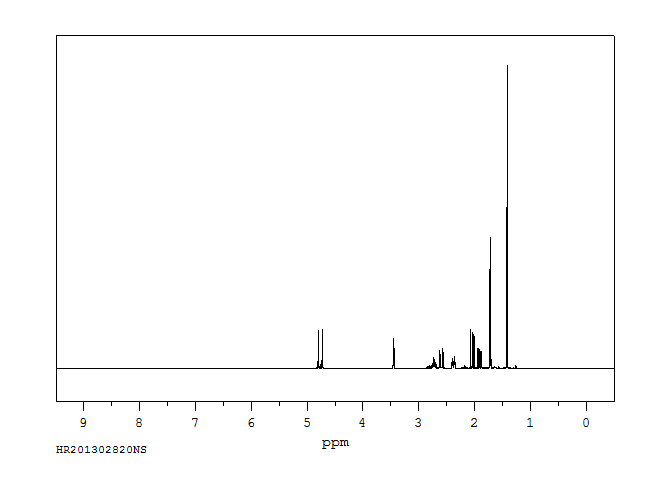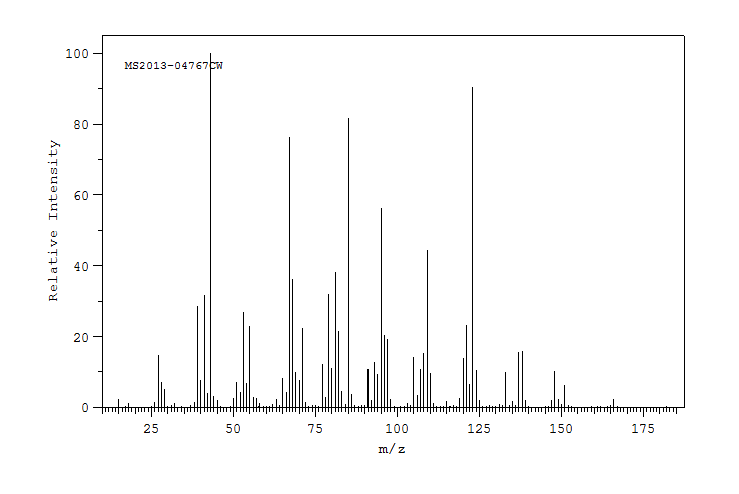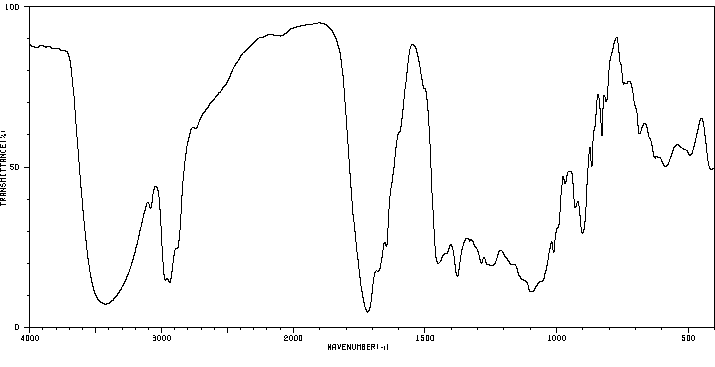carvone epoxide | 33204-74-9
中文名称
——
中文别名
——
英文名称
carvone epoxide
英文别名
carvone oxide;7-Oxabicyclo[4.1.0]heptan-2-one, 1-methyl-4-(1-methylethenyl)-;1-methyl-4-prop-1-en-2-yl-7-oxabicyclo[4.1.0]heptan-2-one
CAS
33204-74-9
化学式
C10H14O2
mdl
MFCD00601314
分子量
166.22
InChiKey
YGMNGQDLUQECTO-UHFFFAOYSA-N
BEILSTEIN
——
EINECS
——
-
物化性质
-
计算性质
-
ADMET
-
安全信息
-
SDS
-
制备方法与用途
-
上下游信息
-
文献信息
-
表征谱图
-
同类化合物
-
相关功能分类
-
相关结构分类
物化性质
-
沸点:120-122 °C(Press: 15 Torr)
-
密度:1.033 g/cm3(Temp: 22 °C)
-
LogP:2.534 (est)
-
保留指数:1261;1262;1262;1251;1261;1266;1260;1263;1261;1261
计算性质
-
辛醇/水分配系数(LogP):1.6
-
重原子数:12
-
可旋转键数:1
-
环数:2.0
-
sp3杂化的碳原子比例:0.7
-
拓扑面积:29.6
-
氢给体数:0
-
氢受体数:2
SDS
上下游信息
反应信息
-
作为反应物:描述:参考文献:名称:Aluminium triiodide: A convenient reagent for deoxygenation of oxiranes摘要:DOI:10.1016/s0040-4039(00)82200-5
-
作为产物:描述:参考文献:名称:设计和合成简单,有效且选择性的基于非环A的基于吡啶并A的酰基辅酶A抑制剂:胆固醇酰基转移酶2(ACAT2)†摘要:通过打开A环的上部设计并合成了一系列基于吡ip烯A的化合物,这大大简化了由市售起始原料制成的结构和合成。代表性化合物(-)-3表现出对ACAT2的有效活性,对ACAT2的选择性比对ACAT1的选择性更大。DOI:10.1039/c5ob02019k
文献信息
-
Activation of H<sub>2</sub>O<sub>2</sub> over Zr(IV). Insights from Model Studies on Zr-Monosubstituted Lindqvist Tungstates作者:Nataliya V. Maksimchuk、Vasilii Yu. Evtushok、Olga V. Zalomaeva、Gennadii M. Maksimov、Irina D. Ivanchikova、Yuriy A. Chesalov、Ilia V. Eltsov、Pavel A. Abramov、Tatyana S. Glazneva、Vadim V. Yanshole、Oxana A. Kholdeeva、R. John Errington、Albert Solé-Daura、Josep M. Poblet、Jorge J. CarbóDOI:10.1021/acscatal.1c02485日期:2021.8.20(Bu4N)2[W5O18Zr(H2O)3] (1) and (Bu4N)6[W5O18Zr(μ-OH)}2] (2), have been employed as molecular models to unravel the mechanism of hydrogen peroxide activation over Zr(IV) sites. Compounds 1 and 2 are hydrolytically stable and catalyze the epoxidation of C═C bonds in unfunctionalized alkenes and α,β-unsaturated ketones, as well as sulfoxidation of thioethers. Monomer 1 is more active than dimer 2. AcidZr-单取代的 Lindqvist 型多金属氧酸盐 (Zr-POM),(Bu 4 N) 2 [W 5 O 18 Zr(H 2 O) 3 ] ( 1 ) 和 (Bu 4 N) 6 [W 5 O 18 Zr( μ-OH)} 2 ] ( 2 ),已被用作分子模型来揭示过氧化氢在 Zr(IV) 位点上的活化机制。化合物1和2具有水解稳定性,可催化未官能化烯烃和 α,β-不饱和酮中 C=C 键的环氧化以及硫醚的磺化氧化。单体1比二聚体2更活跃。酸添加剂大大加速了氧化反应,并将氧化剂利用效率提高到>99%。产物分布表明异裂氧转移机制,该机制涉及在 Zr-POM 和 H 2 O 2相互作用时形成的亲电氧化物质。1和2与 H 2 O 2的相互作用以及由此产生的过氧衍生物已通过 UV-vis、FTIR、拉曼光谱、HR-ESI-MS 和组合 HPLC-ICP-原子发射光谱技术进行了研究。一个之间的相互作用17
-
An Effective Synthesis of Acid-Sensitive Epoxides via Oxidation of Terpenes and Styrenes Using Hydrogen Peroxide under Organic Solvent-Free Conditions作者:Kazuhiko Sato、Yoshihiro Kon、Houjin Hachiya、Yutaka Ono、Tomohiro MatsumotoDOI:10.1055/s-0030-1258467日期:2011.4An efficient epoxidation process for various terpenes and styrenes using a hydrogen peroxide-tungsten catalytic system with organic solvent- and halide-free conditions was developed. In the presence of the catalytic system, Na2WO4, PhP(O)(OH)2, and [Me(n-C8H17)3N]HSO4, and under weak acidic conditions, hydrogen peroxide successfully epoxidized α-pinene to α-pinene oxide in 95% selectivity at 91% conversion
-
METHOD FOR MANUFACTURING AN EPOXY COMPOUND AND METHOD FOR EPOXIDIZING A CARBON-CARBON DOUBLE BOND申请人:Takumi Kiyoshi公开号:US20120108830A1公开(公告)日:2012-05-03The present invention provides a method for producing an epoxy compound, comprising oxidizing a carbon-carbon double bond of an organic compound by hydrogen peroxide in the presence of a neutral inorganic salt and a mixed catalyst of a tungsten compound (a), at least one phosphorus compound selected from the group consisting of phosphoric acids, phosphonic acids, and salts thereof (b) and a surfactant (c), and an epoxidizing method comprising oxidizing a carbon-carbon double bond by hydrogen peroxide in the presence of the catalyst and the neutral inorganic salt.
-
Unique Salt Effect on Highly Selective Synthesis of Acid-Labile Terpene and Styrene Oxides with a Tungsten/H2O2 Catalytic System under Acidic Aqueous Conditions作者:Yoshihiro Kon、Kazuhiko Sato、Houjin Hachiya、Yutaka Ono、Kiyoshi Takumi、Naoki Sasagawa、Yoichiro EzakiDOI:10.1055/s-0031-1290948日期:2012.6styrene oxides are effectively synthesized in high yields with good selectivities using tungsten-catalyzed hydrogen peroxide epoxidation in the presence of Na2SO4. The salt effect is thought to originate with the addition of a saturated amount of Na2SO4 to aqueous H2O2; this addition strongly inhibited the undesired hydrolysis of the acid-labile epoxy products, despite the biphasic conditions of substrate摘要 在Na 2 SO 4的存在下,使用钨催化的过氧化氢环氧化,可以高产率,高选择性地有效合成酸不稳定的环氧化物,例如萜烯和氧化苯乙烯。盐的作用被认为是由于在H 2 O 2水溶液中加入了饱和的Na 2 SO 4引起的。尽管底物为油相且H 2 O 2为酸性水相的双相条件,但这种添加强烈地抑制了酸不稳定的环氧产物的不希望的水解。 在Na 2 SO 4的存在下,使用钨催化的过氧化氢环氧化,可以高产率,高选择性地有效合成酸不稳定的环氧化物,例如萜烯和氧化苯乙烯。盐的作用被认为是由于在H 2 O 2水溶液中加入了饱和的Na 2 SO 4引起的。尽管底物为油相且H 2 O 2为酸性水相的双相条件,但这种添加强烈地抑制了酸不稳定的环氧产物的不希望的水解。
-
A versatile cobalt(II)-Schiff base catalyzed oxidation of organic substrates with dioxygen: Scope and mechanism作者:T Punniyamurthy、Beena Bhatia、M.Madhava Reddy、Golak C Maikap、Javed IqbalDOI:10.1016/s0040-4020(97)00432-8日期:1997.6Cobalt(II) complex 1a-f derived from Schiff bases act as efficient catalysts during the oxidation of wide range of organic substrates(e.g. alkenes, alcohols, benzylic compounds and aliphatic hydrocarbons) with dioxygen in the presence of aliphatic aldehydes or ketones or ketoesters. EPR studies on 1a-f complexes suggest that the aliphatic carbonyl compounds promote the formation of a cobalt(III)-superoxo
表征谱图
-
氢谱1HNMR
-
质谱MS
-
碳谱13CNMR
-
红外IR
-
拉曼Raman
-
峰位数据
-
峰位匹配
-
表征信息
同类化合物
(双(2,2,2-三氯乙基))
(2-氧杂双环[4.1.0]庚烷-7-羧酸乙酯
高壮观霉素
香芹酮氧化物
雷公藤甲素
雷公藤内酯酮
雷公藤内酯三醇
雷公藤乙素
钴啉醇酰胺,Co-(氰基-kC)-,磷酸(酯),内盐,3'-酯和(5,6-二甲基-1-a-D-呋喃核糖基-1H-苯并咪唑-2-胺-2-14C-kN3)(9CI)二氢
钠甲醛2-羟基苯磺酸酯4-(4-羟基苯基)磺酰苯酚
醛固酮21-乙酸酯
醛固酮18,21-二乙酸酯
醋酸泼尼松龙环氧
醋酸氟轻松杂质
螺[1,3-二氧戊环-2,2'-[7]氧杂双环[4.1.0]庚烷]
苯甲酸,4-[3-(三氟甲基)-3H-重氮基丙因-3-基]-,2,5-二羰基-1-吡咯烷基酯
芳香松香
芍药苷代谢素 I
索迪叮
盐(9CI)二氢4H-吡咯并[3,2-d]嘧啶-4-酮,7-[(2S,3S,4R,5R)-3,4-二羟基-5-[(磷羧基氧代)甲基]-2-吡咯烷基]-1,5--,二铵
甲基[(1R,2S,4R,6S)-4-羟基-1-甲基-7-氧杂双环[4.1.0]庚-2-基]乙酸酯
甲基(1S,2S,5R)-1-乙氧基-2-甲基-3-氧杂双环[3.2.0]庚烷-2-羧酸酯
环龙胆四糖全乙酸酯
环氧环己基环四硅氧烷
环氧己烷
泼尼松龙环氧
氧杂环庚-4-酮
氧化环己烯
氧化异佛尔酮
氟米龙杂质
柠檬烯-1 2-环氧化物
景天庚酮糖
明奈德
戊哌醇
强心-4,16,20(22)-三烯交酯,7,8-环氧-11,14-二羟基-12-羰基-2,3-[[(2S,3S,4S,6R)-四氢-3-羟基-4-甲氧基-6-甲基-2H-吡喃-3,2-二基]二(氧代)]-,(2a,3b,7b,11a)-(9CI)
布地奈德杂质15
己二酸,二(4-甲基-7-氧杂二环[4.1.0]庚-3-基)酯
娄地青霉
多纹素
外-顺-7-氧杂二环<2.2.1>庚-5-烯-2,3-二甲醇碳酸酯
吡啶,1,2-二氢-4,5,6-三甲基-2-亚甲基-(9CI)
吡咯烷,1-(2-哌嗪基羰基)-(9CI)
台湾牛奶菜双氧甾甙 B
反式-1,2-环氧-4-叔丁基环己烷
反式-1,2-环氧-4-叔丁基环己烷
双((3,4-环氧环己基)甲基)己二酸酯
去环氧-脱氧雪腐镰刀菌烯醇
卡烯内酯甙
半短裸藻毒素B
十二氟-1,2-环氧环庚烷










